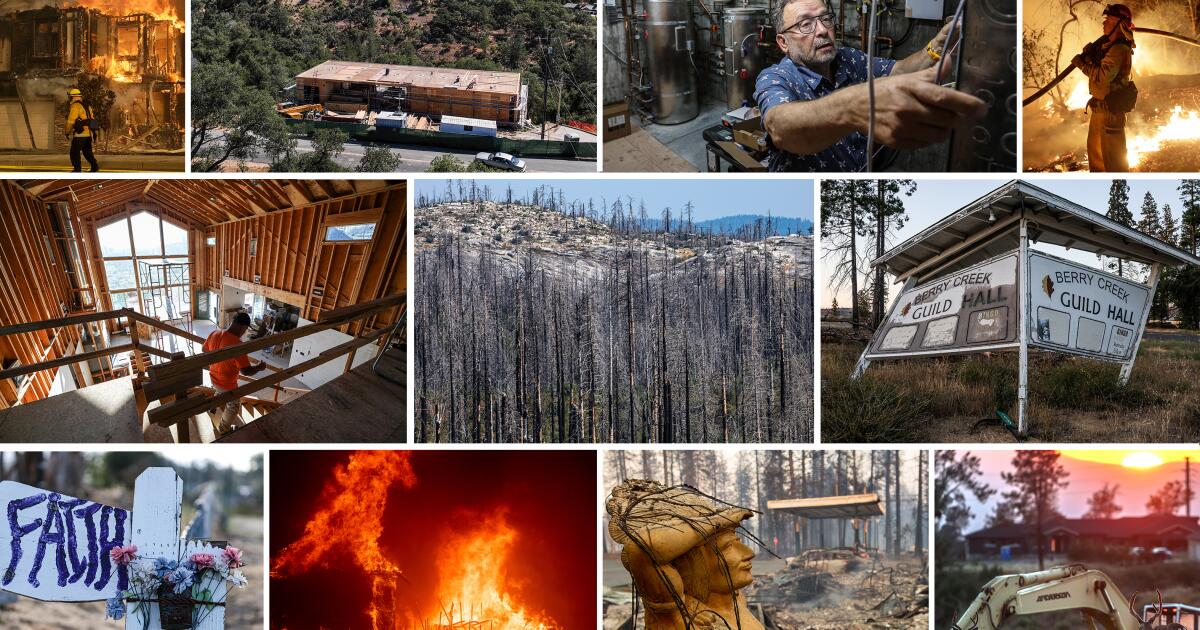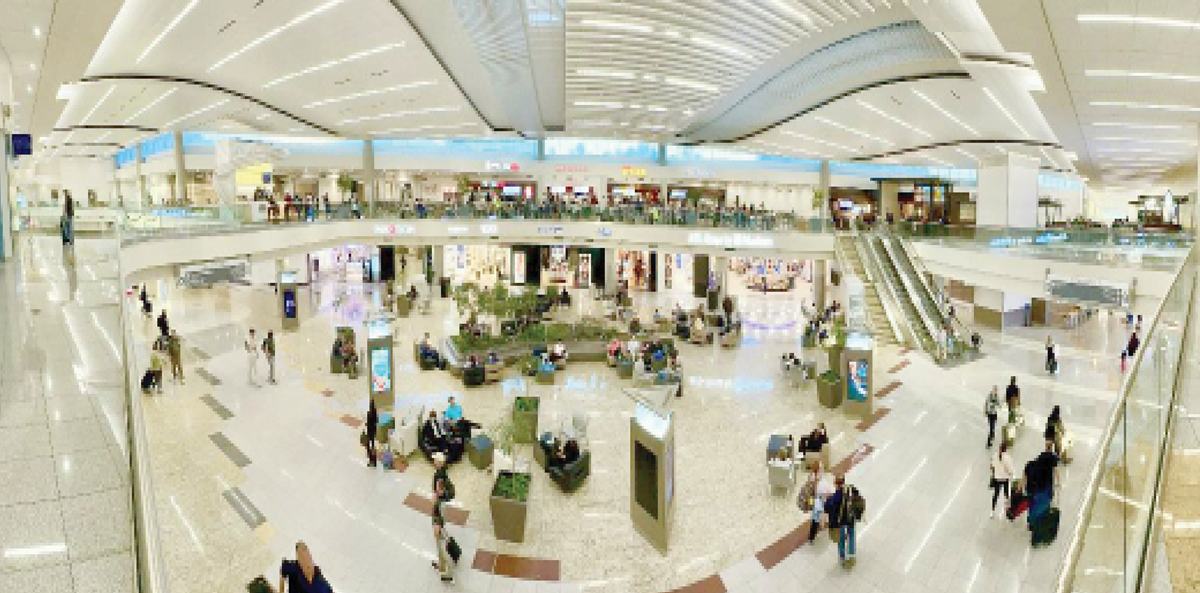
On a hill in Sonoma County, François Piccin yearns to return home.
In fall 2017, Piccin and his wife lost their ranch house when the Tubbs fire roared through Northern California’s famed wine region. Contractors found themselves in high demand and overbooked, and the one the couple hired abandoned the project halfway through. In the time it took to find a new builder, the price tag rose by a third to $2.4 million, forcing the Piccins to sell a rental property they owned to pay the bill.
The home remains unfinished and their lives unsettled.
“Financially, what we’ve done doesn’t make sense,” said Piccin, 66, standing this summer amid cardboard delivery boxes and stray cabinet drawers in his future kitchen. “But emotionally, psychologically, it is a mandate. We need to have this done to be able to close a chapter and turn the page.”
Over the last eight years, wildfires have burned down more houses than at any other time in California history. From the Piccins’ property in wine country to foothills below the Sierra Nevada to canyons overlooking the Pacific Ocean, the wreckage stubbornly resists recovery.
To better understand what Los Angeles might expect after January’s fires, The Times examined the five other most destructive wildfires from this period to document how communities have responded in the wake of disaster.
In total, nearly 22,500 homes were lost in the five blazes, which occurred from 2017 to 2020. Just 8,400 — 38% — had been rebuilt as of April per the Times analysis.
It’s not for lack of trying. In more than 50 interviews, wildfire-affected homeowners and renters, builders, academics, aid workers and government officials described the myriad ways rebuilding has failed. Insurance came up short. Construction costs soared. Red tape stifled. Life intervened. The desire of many fire survivors to return to their homes ran aground amid the challenges.
Now, with 13,000 homes lost this year in Los Angeles County, these experiences offer a scope into the future. Immediately after the blazes, the neighborhoods of Pacific Palisades and Altadena vowed to come back as they were before. Elected officials promised to do everything in their power to make that happen. But the same was said when the earlier fires reduced other areas to rubble.
Not all communities devastated by wildfire have struggled the same, the Times analysis shows. Some have rebounded. Almost 80% of the 4,700 homes burned down in the Tubbs fire have returned. Other places remain deserted. The 2020 North Complex fire destroyed 1,500 homes in Berry Creek and nearby rural areas in the pine forests of Butte County. Seventy-two have been rebuilt.
The differences in the pace of construction reveal patterns. Wealthier, flat, suburban areas have tended to rebuild faster than poorer, hilly, rural areas.
But affluence and urbanity haven’t always played decisive roles. In the middle-class neighborhood of Coffey Park in Santa Rosa, 93% of property owners have rebuilt after the Tubbs fire, The Times found. That rate is almost 20 percentage points higher than the wealthier nearby community of Fountaingrove. More homes have returned after the 2018 Carr fire in Redding and surrounding old mining towns in Shasta County than after the similarly destructive Woolsey fire, which affected Malibu and coastal L.A. County the same year.
Homeowners’ decision to rebuild is highly individualized. Tangible issues, including their insurance coverage and savings, mix with intangibles like family dynamics, the trauma of losing a home and the deluge of choices needed to build a new one. Whatever control fire survivors have over these variables, they have none over many others, such as construction costs, mortgage rates and the restoration of public infrastructure. Even how a fire began matters. When private utilities are at fault, the resulting payouts can make it easier to construct a replacement. But that’s not the case with fires attributed to natural causes.
Indeed, permit applications rose each time survivors of the 2018 Camp fire received installments from a settlement with Pacific Gas & Electric, whose power lines caused the blaze that burned down nearly 14,000 homes in Butte County. North Complex survivors received no such payout. Lightning started that fire.
Many residents initially intent on rebuilding and returning to their properties gave up and decided to move on.
Richard and Pamela Klein spent nearly $200,000 on plans to build a replacement house atop a winding road in Fountaingrove. The terrain made for arduous access to their property and their contractor told them building costs would soar unless they convinced their neighbors to let them truck materials through their then-empty lots. The Kleins offered to pay for the privilege, but the neighbors didn’t agree. Two and a half years after the Tubbs fire, the couple sold their one-acre parcel and moved to the Lake Tahoe area.
“If we knew that we were going to face these hurdles up front, we wouldn’t have even thought of rebuilding,” said Richard Klein, 65.
Though devastated L.A. neighborhoods look more like those that burned in the Tubbs fire than in the mountainous country of the North Complex, experts say that no matter the circumstances property owners and politicians vastly underestimate the time, difficulty and expense of rebuilding.
“It’s a marathon sprint,” said Andrew Rumbach, a senior fellow at the Washington-based Urban Institute, where he studies disaster response. “It’s going to take a really long time and it’s going to be really intense for a very long time.”
When rebuilds go fast
A month after the Carr fire devoured his home in Redding, Mark Chitwood believed his rebuild was moving too slowly.
He couldn’t get ahold of his insurance adjuster, so he searched for phone numbers of company executives. He found one and unloaded his grievances on her.
“To say the least, I was a little pissed off,” said Chitwood, 64. “I’m not one to sit around and wait for things to happen.”
Within days, a new adjuster arrived. The check followed and Chitwood got going. A local Realtor, Chitwood and a contractor friend had built 120 new houses together, including, only four years before the fire, his home and others in the upscale Land Park subdivision. The house’s foundation survived, so Chitwood kept the same footprint, redesigned the interior and hired his friend to do the work.
In March 2019, just eight months after the blaze, Chitwood entered a finished three-bedroom house, one of the fastest rebuilds in any of the five fires analyzed by The Times.
When he walked into his new living room and sank into his new recliner it felt like home again.
Chitwood’s story ticks many of the boxes recovery experts say are needed to return rapidly. Living in a subdivision with houses close together allowed debris cleanup to move efficiently. His insurance paid out in full with only the brief delay. His prior experience building houses gave him a huge advantage navigating the process.
“For me, it was easy to do,” Chitwood said. “A lot of people were overwhelmed.”
The reasons individual homeowners and entire neighborhoods can rebuild fast after fires come down to personal circumstance and community dynamics. People with high incomes or substantial savings have clear advantages, but that’s not all that matters.
Santa Rosa’s Coffey Park and Fountaingrove neighborhoods saw most of their development in the 1980s and ‘90s, the former made up of planned subdivisions with look-alike starter homes and the latter a hilly refuge for luxury custom living.
In October 2017, the Tubbs fire blazed through Fountaingrove before jumping the 101 Freeway to Coffey Park. It wiped out both areas, taking a similar number of homes in each and 2,700 between them.
Fountaingrove’s relative affluence didn’t mean residents returned more quickly. Like the Kleins, many struggled with the logistics of building custom homes on large, irregularly shaped lots amid sloping terrain.
By contrast, Coffey Park is flat and divided into compact, similarly sized parcels. The layout provided an incentive for homebuilders to develop a handful of models that could fit on most properties. Builders had multiple homes under construction at the same time, allowing them to work quickly and at scale with little lag time between jobs across the cul-de-sacs. The process provided more predictable costs and timelines for builders and residents, and opened opportunities unimaginable in the hills across the freeway.
Before the fire, Jeff Okrepkie and his wife were Coffey Park renters. They wanted to remain in the neighborhood and planned to use the money they received from their renters insurance as a down payment on a new house. Various prospects fell through until Okrepkie noticed that a builder had purchased a lot on their old street to store materials for other homes under construction.
The builder and Okrepkie worked out a deal: He’d select a design from the builder’s catalog of homes and buy the property once all the construction, including theirs, was complete. They signed a contract and Okrepkie eagerly watched its progress in the construction pipeline.
“I was house number 82,” Okrepkie said. “I found out where 81 was and I would go see what they were doing and say, ‘Oh, they’re doing windows? Cool, I’m getting windows next week.’’’
Okrepkie’s family, which by then included two young children, moved in 2½ years after the fire.
Unlike in Fountaingrove’s spread-out hills, rebuilding in Coffey Park become a communal event. Soon after the fire, Okrepkie and neighbors formed a group called Coffey Strong. The organization advocated for area survivors, served as a sounding board to vet contractors and, at times, functioned as group therapy. For years, neighbors would hold weekly get-togethers, at first on burned-out lots and later at housewarming parties. They called the gatherings “Wine Wednesdays,” a name that captured their imbibing and venting.
The organization operated as a virtuous circle for rebuilding, encouraging residents to keep going, said Okrepkie, 46.
“Indirect social pressure existed,” said Okrepkie, who has since been elected to the Santa Rosa City Council. “Like, ‘I don’t want to be the last one in.’ The thing you tend to really miss is your community.”
Coffey Park’s location provided an additional advantage over Fountaingrove when it came to insurance. Before the fire, insurance in Coffey Park was more affordable because the neighborhood was considered at lower risk of burning. Combined with lower property values and cheaper rebuilds, many Coffey Park residents had purchased enough coverage to finance their return, as noted by Grist reporter Jake Bittle. The topography of Fountaingrove was a significant fire hazard. No matter its relative wealth, the significant expense of insuring high-value homes in a high-risk neighborhood meant that homeowners there had lesser coverage. Payouts were too small to pay for their costlier, custom rebuilds.
Racing the insurance clock
Insurance companies had to provide coverage for temporary living expenses for two years, which meant that if Tubbs survivors were going to return, many needed to do so relatively quickly. Coffey Strong later lobbied for a change in state law that required companies to cover such expenses for three years in future fires.
Without that private subsidy, survivors would have to pay the mortgage on their destroyed property and the rent for their temporary housing — on top of any gaps in construction costs not covered by insurance for the new home.
City officials were acutely aware of the insurance deadline, said Gabe Osburn, Santa Rosa’s director of planning and economic development. Osburn said the city gave homeowners breaks on many rules, including reducing fees and landscaping requirements, to help people meet the target.
“It was two years or bust,” Osburn said. “We were working under that timeline. If we don’t get this done in two years, then they’re going to sell the property.”
Osburn said it was important to city officials not only that homes were rebuilt, but also that original owners could come back. Structures don’t make up a neighborhood’s character, he said, the people who live there do.
“You really want to maintain the fabric of your community,” he said.
The two-year mark fell squarely in the largest surge of construction in Santa Rosa and elsewhere after the Tubbs fire. Nearly 60% of all the houses that have been rebuilt were finished between 1 1/2 and 3 1/2 years following the blaze, The Times found. Over the nine-month peak of rebuilding, more than three families a day were moving back into their homes.
The dearth of construction after the North Complex fire makes it an outlier. But although the pace and extent of building after the Carr, Camp and Woolsey fires have been slower and smaller than after Tubbs, a general pattern has held. In all of them, it took seven to nine months for the first house to be completed. Development rose from there and reached its monthly peak between the second and third year. By year four, progress dropped significantly.
This consistency in the trajectory of rebuilding indicates that permitting stagnation is attributable to the passage of time rather than declining once a certain percentage of homes are rebuilt.
For instance, a majority of the 1,100 houses lost in the Carr fire remain vacant lots seven years later. Of properties with rebuilt homes, about half were occupied between 14 months and 2 1/2 years after the blaze. Now, new completions have trickled to fewer than three a month, less than 20% of that peak period.
Why rebuilds stall
Weeks after the Camp fire destroyed swaths of Butte County in November 2018, Pat Butler returned to her five-acre property in the rolling hills of Concow.
At first, she stayed in a 19-foot metal travel trailer that hadn’t burned. Living off the grid like many in the area, Butler, then 65, was lucky one of her water tanks survived so she could bathe. Her bathroom became a toilet she fastened on top of her septic tank outside and exposed for her neighbors to see — had any of them come back.
Butler was uninsured. She received assistance from the Federal Emergency Management Agency, but it wasn’t enough to start on a new home. She remained in the trailer for two years.
Eventually, an aid group got Butler a camper where she set up rudimentary solar panels and built a porch. With the help of more private aid, the rebuilding process began.
They poured the foundation for her 400-square-foot home on May 12, 2023, a date Butler commemorated in the cement. Every few months, volunteers would come two weeks at a time from Connecticut, Hawaii, Michigan and Washington to assist with the framing, siding and painting. In between, Butler and a local charity worker worked on the house themselves.
She moved in Christmas Eve.
“This past winter was the first in six years that my feet were warm,” said Butler, now 71.
Butler could stay because of her dedication to her land and the private assistance she received. But for the vast majority of fire survivors in poor, rural areas, the obstacles to rebuilding have been too great.
Many faced the same challenges with topography that those in Fountaingrove did, but without the financial resources to make up for it. Multiple studies have shown that those living in rural areas are more likely to be uninsured or underinsured. And a lack of essential infrastructure only has added to the hurdles.
Nowhere are the disparities between suburban and rural more clear than in the aftermath of the Carr fire. Redding residents had higher incomes and better insurance than survivors from the unincorporated areas of Shasta County, said Rebecca Ewert, a Northwestern University sociologist who wrote her PhD thesis on Carr fire recovery.
Rebuilding homeowners in Redding also had access to a central sewer system, had their electricity restored by the local utility and street repairs handled by the city. Many residents of unincorporated communities had none of these, Ewert said. Instead, they had to pay upward of tens of thousands of dollars to fix damaged septic systems, reinstall their own power poles and repave the asphalt melted from private roads.
“There were so many additional steps and costs that people in the rural areas had to navigate before even starting to rebuild,” Ewert said.
The Times data show the results of the inequities. Nearly three-quarters of the 260 homes the Carr fire destroyed in Redding have been rebuilt. In unincorporated Shasta County, where 817 houses burned down, fewer than 40% have returned.
Rebuilding after the Camp fire has been even slower, and not only because of the challenges affecting rural areas.
The wildfire remains by far the most destructive in state history, with more homes burned down than the two January blazes in Los Angeles combined. Besides Concow and other sparsely populated unincorporated communities in Butte County, the fire wiped out the 26,000-person town of Paradise. Unprecedented public works and economic problems were left in its wake.
It took two years just to begin cutting down 50,000 dead and dying trees from properties in the burn scar. Paradise’s roads made it through the fire but didn’t survive the cleanup. The parade of dump trucks carting out tons of wreckage buckled the streets; repaving operations continue today. Paradise’s hospital, the town’s largest employer, shuttered permanently, dealing a blow to the jobs and the tax base unlike any faced by survivors of the Tubbs fire in wine country and Woolsey fire in Los Angeles.
The hurdles have fueled a mass exodus. Nearly five years post-fire, property owners were twice as likely to have sold their land as rebuilt their homes, an analysis by the Butte County Assessor’s Office found.
Overall, about a quarter of the homes lost to the Camp fire have been rebuilt. The pace lags behind both the Carr and Woolsey fires, which have rebuilding rates of 47% and 41%, respectively.
How government tilts the playing field
In the wake of these major wildfires, the federal government has provided substantial funding for recovery. It has allocated more than $1.5 billion toward long-term relief efforts following the five fires and other disasters in California from the same years. The dollars are on top of assistance FEMA provided to individuals immediately after the fires.
Yet the money almost always came with strings attached, leaving survivors and recovery workers maneuvering to match the funding with actual needs. The same is true for other federal and state programs that disaster-affected areas could tap for rebuilding.
After the Camp fire, Butte County pursued a state grant to pay for a small community wastewater system in a commercial area that burned. Officials reasoned it would be best to install when no one was living there and that its completion could spur the return of homes and businesses. But the state turned down the request because only populated areas were eligible.
“Nobody after a disaster hands you a pot of money and says, ‘Go do the best and highest,’ ” said Katie Simmons, deputy chief administrative officer for Butte County, who is overseeing recovery efforts. “It’s like, ‘Go do the impossible and then we might reimburse you.’ ”
The other primary way that government affects rebuilding is through permitting. Officials at all levels promised to streamline the process. Then-Gov. Jerry Brown touted his actions “to cut red tape” while touring fire-ravaged Malibu after the 2018 Woolsey fire. Gov. Gavin Newsom committed to doing the same within days of January’s fires in L.A.
Yet many survivors remain stuck, especially where rules are the strictest. Along the California coastline, overlapping layers of regulations make it hard to build at any time. When fire strikes, homeowners can find the circumstances unforgiving.
In a canyon overlooking Paradise Cove, melted steel beams protrude from a concrete foundation that survived Woolsey. It served as the base for the Zilinskas family’s once, and they hope future, home. But nearly seven years after the blaze, they haven’t secured their permits.
Their old home, completed in the early 1990s, was three floors. But they’re shrinking the new house into two. Gene Zilinskas, a retired sonar engineer, is 85 and his wife Dagmar, a former art teacher, is 93. They want fewer stairs than before. They’ve planned for two bedrooms, a kitchen and main living area on the top floor with a bedroom for their daughter below, a layout that also adapts to the hillside and their remaining foundation. But the plan conflicted with city of Malibu rules that say second stories can’t be larger than the first.
That dispute was among many that the family has needed to resolve with permitting officials. They’ve now run into topographical problems with widening their driveway to meet new fire access requirements. The Zilinskases now are on their third architect. The first, fed up with failing to get the home approved, quit. The second died.
“There’s this sense of powerlessness, of not being the captain of your own ship,” said their daughter Beatrix Zilinskas. “Everybody is chronically depressed, this feeling of having absolutely no say so with what’s going on in your life.”
Because of their ages and the time it has taken to receive a permit, the elder Zilinskases believe it’s unlikely they’ll ever walk into their new home.
Malibu officials said the city had trouble verifying records from the Zilinskases’ previous house and aligning the new plans with updated building codes, especially with the multiple architects.
“I feel so bad for the family,” said Yolanda Bundy, Malibu’s community development director. “They’re almost there.”
Bundy said Malibu has changed its rebuilding rules after Woolsey. The city hopes it will make the process smoother for the hundreds more Malibu residents who lost their homes in January’s Palisades fire. The city is assigning its most experienced planners to handle rebuilding rather than relying on contract workers as they did before. Recently, the city updated its codes to make issues like the second-story rule that ensnared the Zilinskases easier to overcome, she said.
“We are really listening and trying to be more flexible,” Bundy said.
With little sign of California’s unprecedented era of wildfire ending, many other communities may have to learn similar lessons. Decades of homebuilding in forests and foothills have left millions of residents exposed as climate change fuels longer, hotter and drier fire seasons.
Seventy percent of the 20 most destructive wildfires in state history have burned since 2017, according to the California Department of Forestry and Fire Protection. All but two have occurred after the turn of the century and none before 1991. The Tubbs fire from fall 2017 was the worst until Camp a year later. The Eaton and Palisades fires then jumped to second and third on the list.



